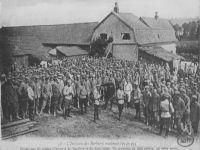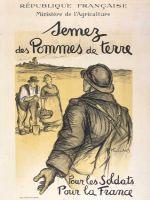Flash info

Fermeture de la salle de lecture
Fermeture annuelle de l'accueil du public du 24 décembre 2025 à 17h00 au lundi 5 janvier 2026 à 9h00.
Archives
On the eve of the Great War, the department of Seine-et-Marne covered an area of 5931 square kilometres with 591 thousand hectares of arable land. Its industry and commerce were booming thanks to its excellent road system. According to the 1911 census, its working population was 43,117 people.
In early August 1914, when war was declared, 14,000 farmers and farm employees were mobilized. Later, other classes lost people to the conscription, bringing the total to 18,434 - or 42.75% of the agricultural workforce.
The first task required of non-mobilizable men, women and children was the immediate replacement of all the men who had gone to the front. Their dedication and spirit of solidarity helped to mitigate the problem, initially by completing the harvest and the autumn ploughing. However, the absence of agricultural machinery, requisitioned along with fuel and horses, made the loss of labour even more acute.

In the autumn, while the men were still at the front and the Battle of the Marne was in full swing in the northern department, the following groups were needed :

Seine-et-Marne newspapers published at the time (L'Abeille de Fontainebleau, La Croix de Seine-et-Marne) show that mobilized farmers often feared the massive influx of workers whom they could not control - because they were at the front, because they were no longer masters of their own farms, or because they feared for the safety of their wives. The women were not used to seeing foreign workers in their fields. Thus, each group of foreign workers or PoWs was supervised by a military guard.
The department was also torn between the need to provide subsistence to the army bases, the troops in its territory, troops on the front and to the civilians and refugees that were flooding into the area. The women, when they could get to their land, were more often than not content to maintain family production but were significantly disadvantaged by taxes on wheat, grain, livestock and sugar. Also, the battles and the billeting of armies destroyed crops or damaged the land. The deployment of ammunition depots in the middle of villages and fields also caused land to be requisitioned.
At the end of the war, farmers and agricultural labourers in Seine-et-Marne paid a heavy price. In December 1919, the Departmental Directorate of Agricultural Services sent the prefect and investigation with an attached statistical report. It revealed that 6,985 farmers, 34% of the mobilized total, had been killed or had left. In addition, there were 643 disabled veterans with limited work capacity. Finally, the collapse in male workers aged 30 to 60 was not offset by the growth in female workers, which led to a severe labour shortage.
Document shelf marks enable the documents to be viewed in the reading room of the Seine-et-Marne Departmental Archives.